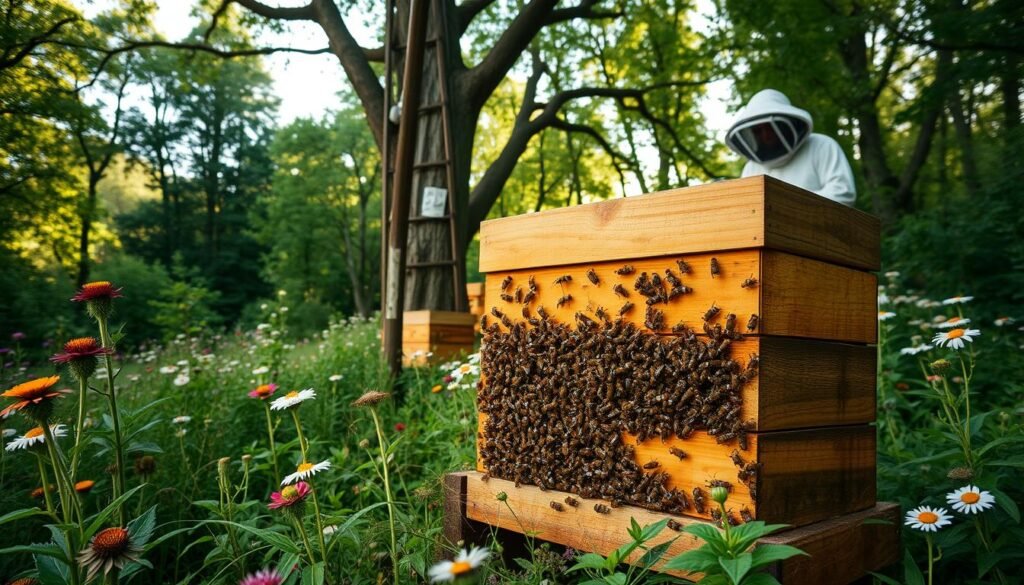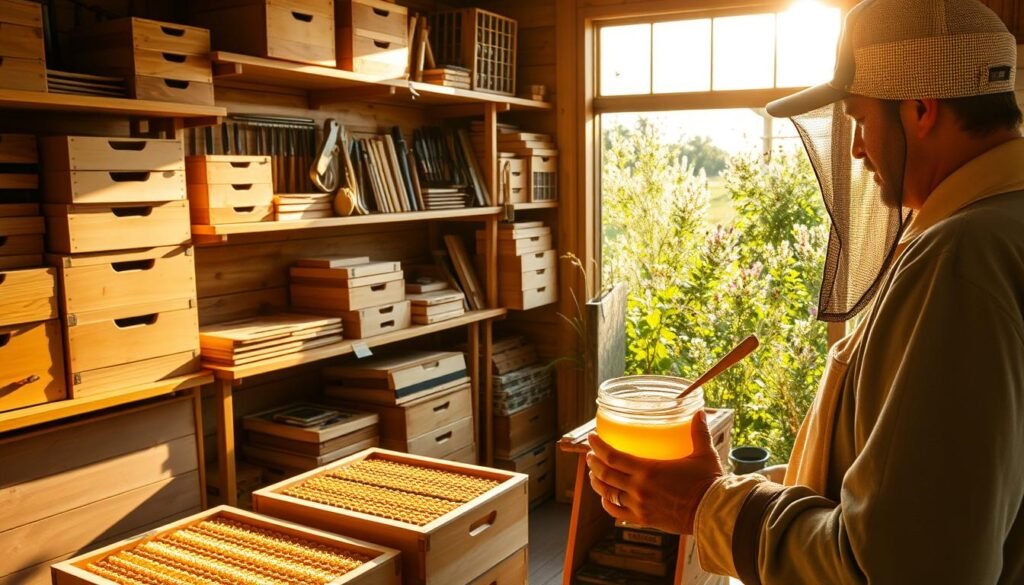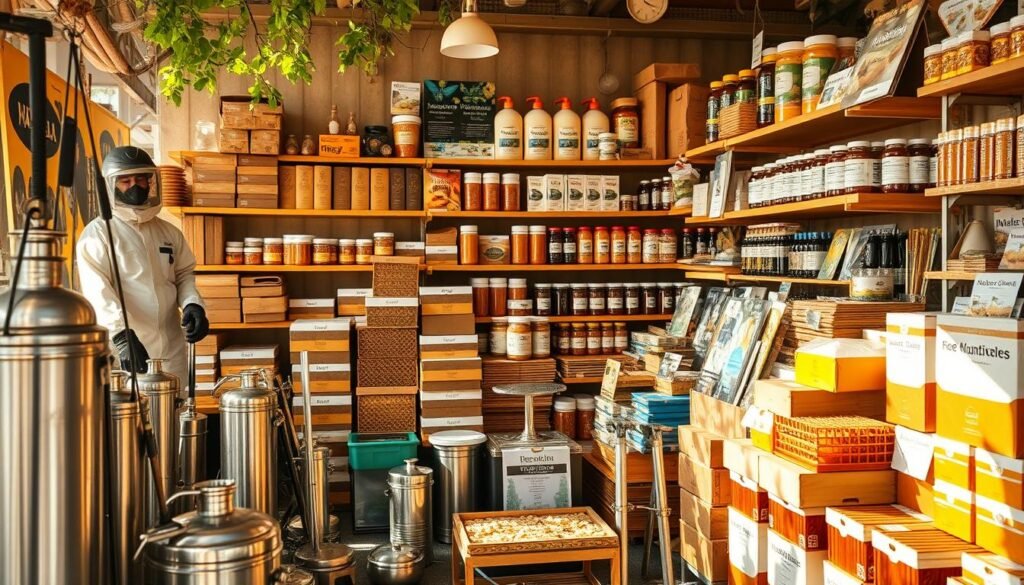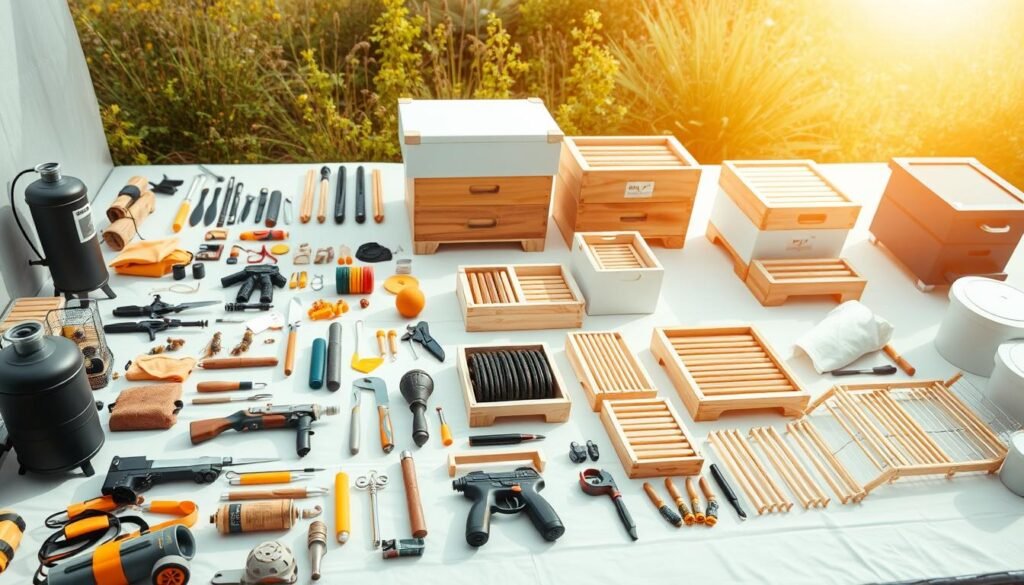Honey bees serve as essential pollinators, supporting gardens, crops, and native plants across Australia. Their survival directly impacts food production and biodiversity. Yet these industrious insects face constant threats from predators eager to exploit their hives.
From rainbow bee-eaters to invasive wasps, natural predators target both adult bees and their larvae. Crab spiders ambush workers mid-flight, while possums raid hives after dark. Even smaller pests like wax moths weaken colonies by destroying comb structures.
Australian beekeepers encounter unique challenges. Local wildlife adapts quickly to hive defences, and introduced species create additional pressure. Effective management requires understanding seasonal patterns – predation spikes during warmer months when colonies are most active.
Key Takeaways
- Honey bee survival impacts food systems and native bushland
- Predators range from birds to mammals and parasitic insects
- Australian apiaries battle both native and invasive species
- Colony threats include direct attacks and internal infestations
- Seasonal changes influence predator activity levels
This guide combines scientific research with practical insights from commercial apiarists. Discover how to identify risks and implement protective strategies tailored to Australian conditions.
Introduction to Bee Predators
In Australia’s diverse landscapes, honey bees drive ecological balance through relentless pollination efforts. Their work sustains native bushland, orchards, and commercial crops – from macadamia plantations to backyard veggie patches. Without these insects, over 65% of flowering plants would struggle to reproduce.
Role of Honey Bees in the Ecosystem
As keystone species, honey bees shape entire habitats. Their pollination services help maintain genetic diversity in wildflowers and boost yields for farmers. A single colony can visit up to 300 million flowers each season, creating ripple effects across food chains.
Overview of Natural Threats to Colonies
Australian hives face dangers from multiple fronts. Native predators like sugar gliders raid nests for larvae, while invasive Asian honey wasps ambush workers. Environmental pressures – droughts, bushfires, pesticides – compound these biological threats.
Rural colonies often battle larger mammals, whereas urban hives contend with clever parrots that dismantle hive boxes. Seasonal changes intensify risks – spring’s population boom attracts more predators seeking easy meals.
Key Predators: What Eats Bees
Australia’s bee colonies face relentless pressure from predators adapted to exploit hive resources. Both native and introduced species target hives through distinct strategies – some dismantle defences systematically, while others overwhelm through sheer numbers.

Insect Adversaries – Hornets, Wasps, and Wax Moths
Wax moths rank among the most destructive infiltrators. Lesser and greater species tunnel through comb structures, consuming beeswax and larval remains. Their larvae leave telltale silk trails that cripple hive functionality.
Hornets and wasps employ different tactics. Asian honey wasps ambush returning foragers, while European hornets raid weak colonies. Though they rarely destroy entire hives, their constant harassment stresses bee populations and reduces honey production.
Mammalian and Avian Predators
Birds like the rainbow bee-eater snatch workers mid-flight. The European honey buzzard demonstrates specialised adaptation – dense facial feathers protect it while extracting larvae from nests. “These raptors time their attacks to coincide with peak hive activity,” notes apiarist John Peterson.
Nocturnal mammals present unique challenges:
- Brush-tailed possums pry open hive boxes after dark
- Antechinus marsupials steal brood comb for protein
- Black rats target stored honey during winter scarcity
Effective defence requires understanding each predator’s habits. Beekeepers must adapt strategies seasonally as threat profiles shift with weather patterns and food availability.
Impact of Predators on Hive Health
Predator attacks leave lasting scars on bee colonies, threatening their survival and productivity. Early detection of hive damage proves critical for maintaining colony numbers and honey yields. Vigilant beekeepers watch for subtle clues that reveal unwelcome visitors.
https://www.youtube.com/watch?v=70Djs1DWL6I
Signs of Hive Intrusion and Damage
Scratch marks near entrances often signal skunk raids. These night hunters leave hollow bee bodies scattered on the ground – evidence of selective feeding. Mouse infestations create distinct patterns: urine odours permeate comb structures, while shredded moss nests occupy multiple frames.
Varroa mites target both adult insects and developing brood. Infested pupae display reddish-brown parasites clinging to their bodies. Heavy mite loads weaken flight muscles, making foraging trips dangerously inefficient.
Effects on Colony Stability and Productivity
Persistent attacks trigger colony stress responses. Workers divert energy from honey production to repair hive structures. Queens may reduce egg-laying as guard bees battle invaders, slowing population growth.
Severe infestations force colonies to abandon hives entirely. “A mouse-ridden colony loses 40% of winter stores on average,” observes NSW Apiarists’ Association data. Integrated pest management combines physical barriers, biological controls, and targeted treatments to break this destructive cycle.
Protection and Management Strategies
Australian beekeepers require layered defence systems to safeguard colonies against diverse predators. Strategic planning combines physical barriers, environmental adjustments, and seasonal awareness to outsmart persistent animals targeting hives.

Preventative Measures and Hive Maintenance
Elevating hives 30-45cm deters skunks forced to expose their bellies to stings. Install ratcheting tie-downs before badger activity peaks in autumn. “Weighted lids prevent midnight raids by possums better than bricks,” advises NSW Beekeepers Association.
Essential maintenance practices:
- Clean equipment storage in frost-prone rooms kills wax moth larvae
- Replace old comb every 3 years to eliminate pest residues
- Conduct weekly inspections during wasp season
Using Natural and Technological Deterrents
Electric fencing remains the gold standard against bears in bushland apiaries. Some professionals bait wires with fish oil to reinforce negative associations. Solar-powered models provide reliable protection in remote locations.
Technological solutions complement traditional methods:
- Infrared cameras detect nocturnal intruders
- Entrance reducers with 8mm holes block mice
- Hive scales alert keepers to sudden weight changes
Practical Tips for Beekeepers in Australia
Position hives in morning sun to deter hive beetles. Rotate apiary sites every 2-3 years to break predator patterns. During drought, increase water sources nearby to reduce competition with animals seeking hydration.
Key regional considerations:
- Tasmanian keepers prioritise quoll-proof latches
- QLD coastal sites require cyclone-rated stands
- Urban apiaries need lockable stands against human interference
Conclusion
Australian beekeepers often manage colonies for years without major predator problems. Experience reveals which animal species pose genuine risks to local hives. Vigorous colonies naturally deter many threats through coordinated defences and rapid comb repairs.
Regional variations demand tailored approaches. Coastal apiaries face different insects than outback operations. Learning from local mentors helps newcomers adapt faster. Most predators target weak hives, making colony health the ultimate safeguard.
Balanced strategies prove most effective. Electric fencing stops mammals, while entrance reducers block smaller invaders. Solar monitors track hive weight changes during summer peaks. These tools complement bees’ innate resilience rather than replacing it.
Understanding natural predators strengthens sustainable practices. Native species maintain ecological balance while managed hives thrive. With proper preparation, Australian beekeepers protect their honey sources and support vital pollination networks across diverse landscapes.




